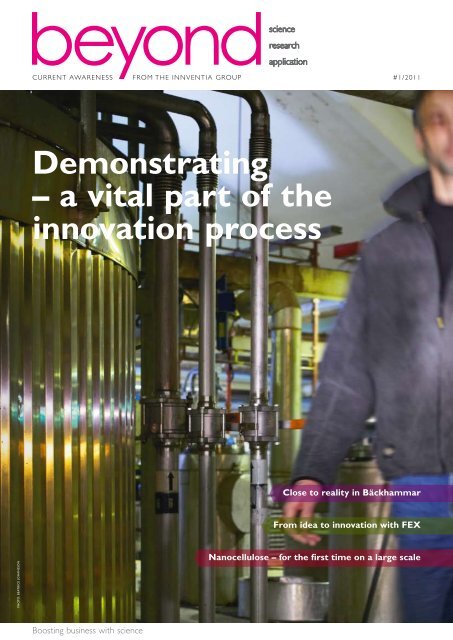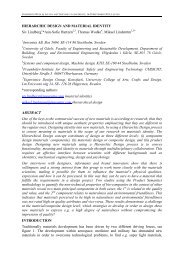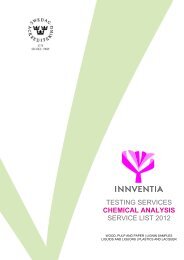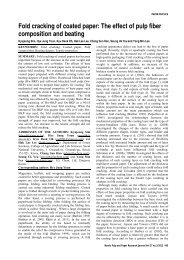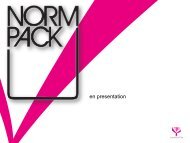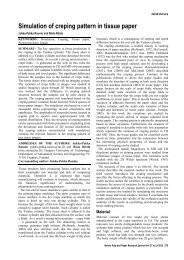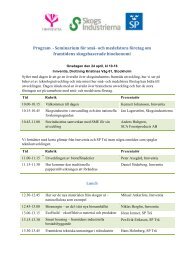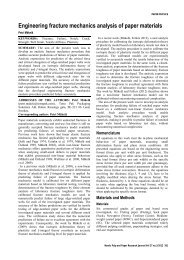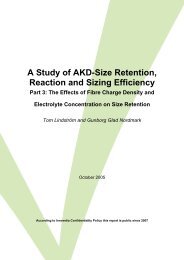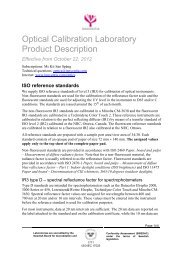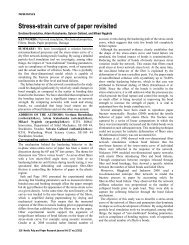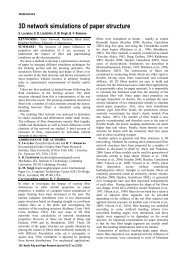Beyond 1, 2011 - Innventia.com
Beyond 1, 2011 - Innventia.com
Beyond 1, 2011 - Innventia.com
You also want an ePaper? Increase the reach of your titles
YUMPU automatically turns print PDFs into web optimized ePapers that Google loves.
current awareness<br />
from the INNVENTIA group<br />
#1/<strong>2011</strong><br />
Demonstrating<br />
– a vital part of the<br />
innovation process<br />
Close to reality in Bäckhammar<br />
From idea to innovation with FEX<br />
photo: beatrice johansson<br />
Nanocellulose – for the first time on a large scale<br />
Boosting business with science
Demonstrating – a vital part of<br />
the innovation process<br />
Nowadays, the term R&D&I is often used instead of the<br />
traditional R&D. The added ‘I’ naturally stands for innovation.<br />
The reason for using R&D&I is to place emphasis on the<br />
fact that research and development will lead to some form<br />
of in<strong>com</strong>e. This might be by means of a new product, a<br />
new process or a reduction in a load on the environment,<br />
for instance. What does an investment in R&D&I imply, in<br />
relationship to simply R&D<br />
When there is satisfaction in showing new possibilities and<br />
theoretical potential with R&D, it is necessary to prove that a<br />
new possibility is realisable, in effect, by putting the innovation<br />
concept into practice. This is an extra thing that can certainly<br />
be costly, yet it is often a prerequisite for a <strong>com</strong>pany to dare to<br />
make further investment. This is why, in addition to research<br />
and development, more and more public research financiers<br />
see that they also should be supporting the demonstration<br />
stage in the innovation chain.<br />
A <strong>com</strong>plete innovation partner, which <strong>Innventia</strong> strives to<br />
be, has to be able to offer the possibility of demonstrating and<br />
verifying new techniques, new technologies and new ideas,<br />
in practice. <strong>Innventia</strong> ensures this in various ways, depending<br />
on customer needs. This can include test beds for everything<br />
from material testing to consumer perception, pilot plants<br />
for demonstrating or it can be networks of <strong>com</strong>panies with<br />
experience in different parts of a new value chain. <strong>Innventia</strong><br />
is constantly developing, even in this area. Very recently, a<br />
pilot plant was inaugurated for demonstrating a revolutionary<br />
production method for nanocellulose.<br />
Another example of a demonstrator is the LignoBoost Plant<br />
at Bäckhammar. This has paved the way, since the Swedish<br />
Energy Agency, with approval from the EU Commission,<br />
is now prepared to give financial support to a pulp mill to<br />
implement this new technology. There is more to read about<br />
this in the following pages of this issue of <strong>Beyond</strong>, along with<br />
an article on the new extensions made to FEX, which is a<br />
full-scale test bed for paper production.<br />
At FEX, an EU Project is currently in<br />
progress to verify a process at Stora<br />
Enso, concerning the production of a raw<br />
material- and energy-saving paper, using<br />
the Aq-Vane technique.<br />
Helena Vollmer<br />
Marketing Director, <strong>Innventia</strong><br />
Close to reality<br />
in Bäckhammar<br />
For the past four years, <strong>Innventia</strong><br />
has been operating a demonstration<br />
plant in Bäckhammar, near<br />
Kristinehamn in Sweden. The plant<br />
is an important cornerstone in<br />
<strong>Innventia</strong> biorefinery operations.<br />
Among other things, the plant<br />
produces lignin, which can be used<br />
to produce carbon fibre in future.<br />
Stefan Andersson at the Metso press filter used for washing of the lignin.<br />
Niklas Berglin, who is responsible for<br />
the technical operations at Bäckhammar<br />
says, “It’s possible to produce large<br />
amounts in the demonstration plant to<br />
the exact quality required for research<br />
and development work. When it <strong>com</strong>es<br />
to what we call carbon fibre lignin, its<br />
purity is the most essential thing. We<br />
are currently carrying out tests with<br />
improved washing to obtain as clean a<br />
lignin as possible.”<br />
The industrial environment is important.<br />
The Bäckhammar plant has got<br />
all necessary infrastructure, with tanks,<br />
pumps, steam, cooling water and, not<br />
least, employees that possess the right<br />
expertise. The plant utilises black liquor<br />
from several mills and the production<br />
can be adapted to requirements. This<br />
means that it is possible to produce<br />
large amounts of the material with a<br />
2 | <strong>Beyond</strong> #1/<strong>2011</strong> Current awareness from the <strong>Innventia</strong> Group
Niklas Berglin is responsible for the technical operations at Bäckhammar.<br />
Black liquors from all over the world can be tested in the<br />
LignoBoost Demo plant.<br />
particular purity for a certain project in<br />
a few weeks and then, the next moment,<br />
reorganise production.<br />
However, the purpose of the demonstration<br />
plant is not only to produce<br />
material for further research and development.<br />
An equally significant task for<br />
the plant is to convince end customers<br />
that a process actually works under<br />
industrial conditions.<br />
“A demonstration plant is as close<br />
to industrial reality as you can get. It<br />
doesn’t just offer the possibility of scaling<br />
up from the laboratory or a pilot<br />
plant. We can operate continuously over<br />
long periods and, as a result, have time<br />
to discover problems, if any, that might<br />
arise on an industrial level. This gives<br />
us the opportunity to optimise a process.<br />
For us, who work in R & D, it’s very<br />
interesting to be faced with more production<br />
related matters, such as staffing<br />
and the working environment.”<br />
Although Niklas is involved in planning<br />
and coordination of the work together<br />
with the site manager Jan Emilsson,<br />
most of the project work is initiated and<br />
carried out by project managers and engineers<br />
from <strong>Innventia</strong>, often doubling the<br />
work force during trials. The production<br />
of high purity lignin is just one example<br />
of what can be done now. Niklas mentions<br />
several other assignments, such as<br />
washing and filtering trials, the testing of<br />
conveyors, drying various kinds of biofuels,<br />
producing low-lignin black liquor for<br />
industrial trials, as well as producing a<br />
pumpable product by <strong>com</strong>bining lignin<br />
with liquid fuels. Many of the projects<br />
are linked to the on-going LignoFuel<br />
Programme and the “Energy & Biofuels”<br />
Cluster at <strong>Innventia</strong>.<br />
Niklas continues, “One on-going<br />
project is to set up a portable system<br />
that can be taken around to different<br />
mills to test the mixture of liquid fuel<br />
in a lime sludge kiln, for instance. You<br />
learn about handling and transporting,<br />
when working with large amounts of a<br />
product. If lignin fuel is going to be a<br />
<strong>com</strong>mercial product, it’s vital to find a<br />
way that works, when it <strong>com</strong>es to handling<br />
it, even for <strong>com</strong>panies that are not<br />
pulp and paper mills. Pellets and powder<br />
are just two examples of the forms that<br />
are suitable for handling refined biofuels.<br />
We focus on both of these, when u<br />
Quantity, Flexibility<br />
& Collaboration – a<br />
recipe for successful<br />
development work<br />
One person who has been to Bäckhammar<br />
several times is Maria Björk, who works<br />
at the Stora Enso Pulp Competence<br />
Centre in Karlstad, Sweden.<br />
“Today, there’s no full size plant.<br />
Through Bäckhammar, we’ve got a picture<br />
of what it’s going to look like and we<br />
have the opportunity of learning about<br />
the process. But the production, itself,<br />
is important too, especially the possibility<br />
of producing large amounts of the<br />
product.”<br />
As an example of this, she mentions<br />
the LignoFuel Programme, in which<br />
lignin, in the form of fuel, is being evaluated<br />
in various applications. One of the<br />
variations is to mix lignin with another<br />
biofuel and burn it in existing biofuel<br />
boilers.<br />
“We see lignin as a possible means<br />
of replacing fossil fuels. Lignin is a new<br />
product and a new fuel, which we don’t<br />
really yet know how to handle. It’s very<br />
important to find out all the effects that<br />
occur at our mill, when the process is<br />
implemented. Lignin production is going<br />
to have a direct influence on energy and<br />
chemical balances at the mill.”<br />
Flexibility is vital for a demonstration<br />
plant. Possibilities must exist for testing<br />
different ideas and process concepts.<br />
Maria sees one of the advantages of a<br />
demonstration plant as providing the<br />
opportunity of visiting it and testing<br />
black liquor from a Stora Enso mill on a<br />
large scale and, from that, learning what<br />
happens when producing lignin from<br />
black liquor that <strong>com</strong>es from a particular<br />
mill.<br />
It has been very interesting for Maria<br />
to collaborate in and follow the development<br />
of lignin from close quarters<br />
in the past years. She is now on the so<br />
called Advisory Board of the LignoFuel<br />
Programme. She emphasises the importance<br />
of collaboration work of this kind.<br />
“It’s the joint efforts in a research programme<br />
that produce results. To guarantee<br />
the future of the pulp and paper<br />
industry, I feel that it’s important to find<br />
new supplementary products.”<br />
Current awareness from the <strong>Innventia</strong> Group <strong>Beyond</strong> #1/<strong>2011</strong> | 3
we’re dealing with lignin and other solid<br />
fuels.”<br />
“The infrastructure that exists at<br />
Bäckhammar offers great opportunities<br />
for extending its operations.” continues<br />
Niklas. “One approach is the utilisation<br />
of sulphur-free pre-treatment to separate<br />
the carbohydrates from the lignin<br />
and then further refine the carbohydrates<br />
into basic sugars. This opens the<br />
door to several possibilities for producing<br />
various specialty products, such as<br />
ethanol and lactic acid that can be used<br />
for making Polylactic Acid (PLA). Then<br />
you also have access to a very pure,<br />
sulphur-free lignin.”<br />
Another interesting route involves the<br />
purification of methanol, which could be<br />
used as a fuel or a chemical.<br />
“The studies being carried out<br />
today are on a laboratory scale but, at<br />
Bäckhammar, we can leave behind the<br />
test tube and work on a significantly<br />
larger scale.”<br />
A flexible plant<br />
makes demands<br />
on creativity<br />
and problem<br />
solving<br />
Every day presents new challenges. When<br />
the employees arrive in the morning,<br />
there might be a couple of boxes with<br />
equipment, waiting to be assembled for<br />
a trial on the following day. Instructions<br />
or diagrams do not always ac<strong>com</strong>pany<br />
them, so it is a question of the employees<br />
being inventive and <strong>com</strong>ing up with<br />
solutions of their own.<br />
“Due to the fact that new processes<br />
are constantly being developed and different<br />
equipment is being tested, you<br />
always have to learn new things. But,<br />
Leif Swärd and Jan Bernhardsson.<br />
Carina Nordberg, Jan Emilsson and Stefan Andersson in the control room.<br />
we have a green light for our own ideas.<br />
We are given a task that has to be solved<br />
some way or another. An example of<br />
this is the Metso press filter used for<br />
washing of the lignin. You can’t find<br />
one in this application anywhere else,<br />
just here. So we simply had to teach<br />
ourselves,” explain Leif Swärd and Jan<br />
Bernhardsson, two of the operators at<br />
Bäckhammar.<br />
Working as an operator in the industry<br />
usually means being responsible for<br />
a particular step in a process and no<br />
more. At the Bäckhammar demonstration<br />
plant, such a job looks different. It<br />
involves a more <strong>com</strong>prehensive responsibility<br />
for everything, from loading and<br />
unloading to working in a laboratory.<br />
“This means that our work has more<br />
variety and we’re independent. You feel<br />
more responsible when you’re part of<br />
things and plan everything,” <strong>com</strong>ment<br />
Carina Nordberg and Stefan Andersson<br />
in the control room.<br />
The manager of the plant at<br />
Bäckhammar is Jan Emilsson. He directs<br />
all the different assignments that <strong>com</strong>e<br />
from Project Managers at <strong>Innventia</strong> and<br />
from the industry.<br />
“This kind of industrial collaboration<br />
is very important. Many of the<br />
assignments are really exciting ones, for<br />
instance, the collaboration we have with<br />
Akzo Nobel on the continuous production<br />
of a liquid lignin product.”<br />
All of the operators have been there<br />
since the start, when LignoTech began<br />
producing lignin at Bäckhammar in<br />
1994. Per Tomani, who was the Project<br />
Manager and responsible for the investment<br />
project, when the old “LignoTech<br />
Process” was expanded into the<br />
LignoBoost Process (a demonstration on<br />
a large scale, which could be said to have<br />
been most unusual for an R&D <strong>com</strong>pany,<br />
such as <strong>Innventia</strong>), says that this has<br />
been a great source of assurance.<br />
“The people here are so terrifically<br />
gifted and skilled. They know the Plant<br />
inside and out. It’s such a wonderful<br />
experience working with them.”<br />
c o n t a c t: niklas.berglin@innventia.<strong>com</strong><br />
<strong>Innventia</strong>s demonstrationsfabrik<br />
i Bäckhammar är så nära den<br />
industriella verkligheten man kan komma.<br />
Här finns all nödvändig infrastruktur med<br />
tankar, pumpar, ånga, kylvatten. Genom<br />
att köra kontinuerligt under längre perioder<br />
får man tid att upptäcka eventuella fel<br />
som kan uppstå i industrin. Produktionen<br />
kan anpassas enligt önskemål och man<br />
utnyttjar svartlut från flera bruk. Många<br />
av de pågående projekten är knutna till<br />
det pågående LignoFuel-programmet och<br />
till <strong>Innventia</strong>s kluster ”Energy & Biofuels”.<br />
Här produceras också det lignin med hög<br />
renhet som används i forskningen för att<br />
framställa kolfiber.<br />
Fabriken sysselsätter fem personer. Att<br />
arbeta som operatör i industrin innebär<br />
vanligen att ha ansvar inom ett begränsat<br />
processteg. På fabriken i Bäckhammar ser<br />
rollen annorlunda ut, mer övergripande<br />
med ansvar för allt, från in- och utlastning<br />
till arbete i labb.<br />
4 | <strong>Beyond</strong> #1/<strong>2011</strong> Current awareness from the <strong>Innventia</strong> Group
Profile<br />
Per<br />
Tomani<br />
c o m i n g eve n t s<br />
m a r c h<br />
21 Workshop: Prospects for lignin-based carbon fibres<br />
22-24 Nordic Wood Biorefinery Conference <strong>2011</strong><br />
24 AFORE Workshop<br />
a p r i l<br />
5-7 Course: Product oriented wood supply and fibre processing<br />
13 Defense of dissertation “Packaging Logistics Performance” by Chris Dominic<br />
m ay<br />
4-5 Packaging training<br />
17-19 Meet <strong>Innventia</strong> at SPCI<br />
For further information on <strong>com</strong>ing events, see www.innventia.<strong>com</strong><br />
Perhaps it was a result of his driving<br />
force to bring ideas to fruition that Per<br />
Tomani took up the responsibility of<br />
building up the <strong>Innventia</strong> Lignin Plant<br />
in Bäckhammar. Building up operations<br />
from a concept is something that has<br />
always engaged him.<br />
When Per first started to work at<br />
<strong>Innventia</strong> in 1991, he worked on matters<br />
concerning thepulp mill system closure<br />
– bleaching, non-process elements, separation<br />
technologies and chemical recovery.<br />
Eventually, he was given the role of<br />
business coordinator. This job included,<br />
among other things, developing business<br />
models and being responsible for managing<br />
the Institute’s applications to the EU,<br />
together with sales activities that led to<br />
many interfaces for the <strong>com</strong>pany and for<br />
the team carrying out these activities.<br />
One of the big research programmes<br />
at the end of the 1990s was KAM (the<br />
Ecocyclic Pulp Mill). Per was given<br />
the responsibility of working more with<br />
those applications in KAM, which were<br />
considered as having the best potential<br />
for being realised and to develop them<br />
further in the FRAM (Future Resourceadapted<br />
Pulp Mill) Programme.<br />
“It was very enjoyable, because there<br />
were so many possibilities. In FRAM,<br />
we could together with very engaged<br />
<strong>com</strong>panies and universities show that<br />
our ideas worked and we were given the<br />
opportunity of taking concepts all the<br />
way to pilot scale and full scale trials.”<br />
Per is now leading the LignoFuel<br />
Programme, which is more ‘hands on’, but<br />
he is also in a state of expectation. The<br />
first industrial installations in LignoBoost<br />
involve an impatient waiting time.<br />
“If there’s anything I’m enthusiastic<br />
about, it’s to see it in reality. To see that<br />
what we’re doing will be of use.”<br />
Per’s leisure-time activities include a<br />
great interest in cooking and good wines.<br />
However, fly fishing, skiing, singing in<br />
a choir with approx. 1000 singers also<br />
manage to take up some of his time.<br />
c o n t a c t: per.tomani@innventia.<strong>com</strong><br />
Birgitta Sundblad appointed<br />
President of <strong>Innventia</strong><br />
Birgitta Sundblad has been<br />
appointed the new President of<br />
<strong>Innventia</strong> AB. She will take up her<br />
position on 1 July <strong>2011</strong>, when the<br />
current President, Professor Gunnar<br />
Svedberg, is retiring.<br />
At present, Birgitta Sundblad is the<br />
Global Director of AFH (Away from<br />
Home) Tissue Product Development and<br />
Innovation at SCA, where she has had<br />
various appointments for a little more<br />
than 12 years. Throughout her career,<br />
Birgitta has worked with research and<br />
development, in which she has had several<br />
leading positions in the chemical<br />
and forest industries.<br />
“Birgitta Sundblad’s experience in<br />
research and development work, with<br />
its emphasis on the customer and consumer,<br />
will strengthen the development<br />
of <strong>Innventia</strong> in being a world-leading<br />
innovation partner,” states Director Mats<br />
Nordlander, Chairman of the <strong>Innventia</strong><br />
Board.<br />
Birgitta Sundblad <strong>com</strong>ments, “I feel<br />
both proud and honoured to be given this<br />
challenge. I believe that my experience<br />
as manager of interdisciplinary teams<br />
will be a very good foundation for building<br />
a strong, well structured <strong>com</strong>pany,<br />
together with everyone at <strong>Innventia</strong>, not<br />
only to meet the challenges of today but<br />
also of the future.”<br />
Birgitta, 53 years old and a Master<br />
of Science in Chemical Engineering<br />
since 1981, has divided her professional<br />
life between SCA and Eka Chemicals<br />
(Akzo Nobel). During these years, she<br />
has mainly worked with research and<br />
development matters, but she has also<br />
worked in the fields of production, sales<br />
and marketing. She was on the Board of<br />
EIRMA (European Industrial Research<br />
Management Association) from 2007<br />
to 2010 and was consequently the first<br />
woman to be a Vice Chairperson of the<br />
EIRMA Board.<br />
Current awareness from the <strong>Innventia</strong> Group <strong>Beyond</strong> #1/<strong>2011</strong> | 5
From concept<br />
to innovation<br />
with FEX<br />
In the development of research<br />
results into final products and<br />
processes, pilot-scale trials play a<br />
significant role. The <strong>Innventia</strong> pilot<br />
plant for paper production, FEX, has<br />
been assisting in bridging the gap<br />
between laboratory and reality since<br />
the 1980s. The plant has continually<br />
been augmented with up-to-date<br />
technologies. A new flexible stock<br />
preparation department was<br />
recently added to it.<br />
“Our aim is to generate an<br />
environment, where our customers<br />
can <strong>com</strong>e and develop their<br />
processes and products in an<br />
industrially relevant way,” states<br />
Torgny Persson, Director of Material<br />
Processes, one of the Business<br />
Areas at <strong>Innventia</strong>.<br />
Instead of interrupting production and<br />
carrying out expensive tests and trials in<br />
their own mills, paper and pulp producers<br />
and suppliers are able to test new<br />
concepts and processes in the FEX Pilot<br />
Plant. Also many research projects utilise<br />
the plant to verify their results and<br />
produce demonstrators from a project.<br />
For example, with the aid of FEX,<br />
it is possible to show what a paper is<br />
like in reality, when using the stratified<br />
forming technology during paper<br />
production. <strong>Innventia</strong> worked with this<br />
in Ecotarget, a large EU Project that<br />
finished in 2008.<br />
“With the aid of full-scale trials, we<br />
can prove that the research results work<br />
in reality, which is worth a lot when it<br />
<strong>com</strong>es to taking research results even<br />
further. With our new plant for producing<br />
nanocellulose on a large scale we can<br />
prove it also there. Without doubt, this<br />
has been of enormous interest to our<br />
customers.”<br />
In addition to a paper machine, the<br />
pilot plant at <strong>Innventia</strong> includes, among<br />
other things, refiners, hydrocyclones and<br />
screens for fractionation. Practically all<br />
the sections are full-scale machines, but<br />
their size is as small as possible. This<br />
means that, during pilot trials, the conditions<br />
that exist are exactly the same as<br />
those at a mill, viz. the same dynamics,<br />
the same speeds and the same conditions.<br />
Torgny continues, “Our knowledge,<br />
expertise and experience in this field are<br />
first rate. We know exactly what to do in<br />
the laboratory and what can’t be tested<br />
in the pilot plant.”<br />
“We’re certain that the results from<br />
our pilot plant are correct. Let’s say<br />
that a parameter increases by fifteen<br />
percent, we can’t guarantee that it will<br />
increase by exactly fifteen percent in the<br />
industrial process. But we can guarantee<br />
that the trend is correct. If there’s an<br />
improvement in a trial held in the pilot<br />
plant, then there’ll be an improvement<br />
in the actual situation in the mill.”<br />
There are very few pilot paper<br />
machines of the same calibre as FEX in<br />
the world that can run at full speed. A<br />
great many experts are attached to the<br />
“With the aid of full-scale trials, we can prove<br />
that the research results work in reality,” says<br />
Torgny Persson.<br />
6 | <strong>Beyond</strong> #1/<strong>2011</strong> Current awareness from the <strong>Innventia</strong> Group
A matter of<br />
proof<br />
The day <strong>Beyond</strong> meets with Dr. Mario<br />
Wiltsche from Andritz, he is attending<br />
a meeting at <strong>Innventia</strong> with other<br />
industry partners. This time, it concerns<br />
a Research Cluster Board meeting<br />
but, previously, his reason for <strong>com</strong>ing<br />
here was often FEX, the pilot paper<br />
machine.<br />
“Pilot trials are very important for our<br />
business. When developing new products,<br />
the concept needs to be proven and<br />
optimized. Pilot trials provide the basis<br />
for a successful market release,” says<br />
Mario Wiltsche.<br />
For him, one of the advantages at<br />
<strong>Innventia</strong> is the perfect environment<br />
for going from laboratory scale to pilot<br />
scale. As an example, he mentions the<br />
development of the Andritz gapformer<br />
PrimeForm TW, for board grades, when<br />
two major series of pilot trials were carried<br />
out in order to optimize this novel<br />
concept. During these trials, Andritz<br />
brought its <strong>com</strong>ponents to FEX, which<br />
had been rebuilt for such work.<br />
“Actually, we are planning a couple of<br />
similar trials right now,” Mario Wiltsche<br />
<strong>com</strong>ments without, giving any further<br />
details.<br />
Pilot trials are also important for<br />
Andritz customer relations. They meet<br />
their customers for joint trials at FEX.<br />
“For instance, we need to validate the<br />
guaranteed production capacity and the<br />
paper quality, achievable by means of a<br />
particular machine concept, so we can<br />
show our customers that their requirements<br />
can be met.”<br />
Mario Wiltsche knows <strong>Innventia</strong> and<br />
its pilot facilities very well. He concludes,<br />
“We are glad to have the opportunity<br />
of making our trials here, not<br />
only for the use of the machine but<br />
also to have <strong>Innventia</strong>’s considerable<br />
knowledge-base available, in the form<br />
of experts, such as Bo Norman, Daniel<br />
Söderberg and Lennart Hermansson,<br />
some of the ‘giants’ in sheet forming.”<br />
pilot plant, including researchers and<br />
world-class specialists, together with the<br />
knowledge and know-how for best preparing<br />
and operating a paper machine.<br />
“I see this as one of our greatest<br />
strengths, the <strong>com</strong>bination of scientific<br />
and practical expertise. We cover everything<br />
from the highest scientific level to<br />
knowing how to operate the machines<br />
In connection to FEX there are many lab<br />
resources, such as this unit for measuring flocking.<br />
These resources are also of great importance for<br />
process and product development.<br />
for obtaining the best results in a process.<br />
The dialogue between the researchers<br />
and those operating the machines are<br />
extremely valuable for our operations<br />
here.”<br />
After the extensions made to FEX,<br />
which were inaugurated a year ago, the<br />
pilot plant is special in another way.<br />
Thanks to the flexible extensions, it is<br />
possible to imitate almost every stock<br />
preparation system. It is very easy to<br />
adapt the pilot plant to meet customer<br />
requirements.<br />
“The pilot plant can offer amazing<br />
opportunities for testing different kinds<br />
of refining in the refining loop. In our<br />
new stock preparation plant, we are able<br />
to look at fractionation and screening.<br />
It’s possible to divide a stock for paper<br />
into different fractions and treat these<br />
fractions in various ways. The different<br />
parts are put together with hoses instead<br />
of pipes, which makes it easy to <strong>com</strong>bine<br />
them in a variety of ways. The latest<br />
news is that we since a month ago also<br />
have pilot plant for producing nanocellulose.”<br />
In recent years, the trend has been<br />
to increase the focus on cost-effective<br />
products, such as an increased content<br />
of fillers in paper products and energy<br />
efficient processes.<br />
“It also be<strong>com</strong>e more <strong>com</strong>mon for<br />
<strong>com</strong>panies to work together, Torgny concludes.<br />
This means that a <strong>com</strong>pany and<br />
its suppliers jointly carry out trials.”<br />
c o n t a c t: torgny.persson@innventia.<strong>com</strong><br />
Istället för att avbryta produktionen<br />
och göra kostsamma tester i<br />
det egna bruket kan pappers- och massatillverkare<br />
testa ut nya koncept och<br />
processer på FEX, <strong>Innventia</strong>s pilotanläggning<br />
för papperstillverkning. Anläggningen<br />
inkluderar bland annat malning, fraktionering<br />
med hydrocykloner, silning och en<br />
pappersmaskin. Vid pilotförsöken råder<br />
exakt samma förutsättningar som man<br />
har i verkligheten på ett bruk: samma<br />
dynamik, samma hastigheter och man får<br />
samma förlopp.<br />
Även många forskningsprojekt använder<br />
anläggningen för att verifiera sina<br />
resultat och kanske ta fram en demonstrator<br />
från projektet. Med hjälp av FEX<br />
gick det t ex att visa hur papperet blir i<br />
verkligheten när man använder stratifieringsteknik,<br />
något som <strong>Innventia</strong> arbetade<br />
med inom det stora EU-projektet<br />
Ecotarget som avslutades 2008.<br />
10 – 14 June, 2012<br />
International Paper Physics<br />
Conference<br />
www.paperconferences2012.<strong>com</strong><br />
8th International<br />
Paper and Coating Chemistry<br />
Symposium<br />
Current awareness from the <strong>Innventia</strong> Group <strong>Beyond</strong> #1/<strong>2011</strong> | 7
Have you changed<br />
address<br />
Let us know by sending an<br />
e-mail to info@innventia.<strong>com</strong>.<br />
B<br />
Nanocellulose – for the<br />
first time on a large scale<br />
The world’s first pilot plant for production<br />
of nanocellulose inaugurated<br />
<strong>Innventia</strong>’s pilot plant for the production of nanocellulose was<br />
inaugurated on 22 February, <strong>2011</strong>. For the first time, it is possible<br />
to produced nanocellulose on a large scale and to study the use<br />
of nanocellulose in applications that require more material.<br />
“For a long time, there’s been a great<br />
deal of interest from the industry in utilising<br />
nanocellulose as a strengthening<br />
<strong>com</strong>ponent in other materials, such as<br />
paper, <strong>com</strong>posites and plastics. In order<br />
to develop such applications, the raw<br />
material produced in a lab is not sufficient.<br />
The new pilot plant is designed<br />
for a production at 100 kg per day,” says<br />
Mikael Ankerfors at <strong>Innventia</strong>.<br />
All sub-steps are now in place in the<br />
process and last week the production<br />
began.<br />
“As the only <strong>com</strong>pany in the world,<br />
we’re extremely proud to be able to offer<br />
the industry real opportunities to participate<br />
in this field, which is so important<br />
for the future. Now we begin to work<br />
towards the next step: the installation of<br />
a full scale process with a partner in the<br />
industry,” concludes Mikael.<br />
The inauguration was attended by<br />
representatives from the industry as well<br />
as, public funders and participants in<br />
research related to nanocellulose. Besides<br />
looking at the new facility opportunity<br />
was offered to take a closer look at samples<br />
of nanocellulose and various examples<br />
of applications such as barrier films,<br />
textile fibres and nanofoams made from<br />
nanocellulose.”<br />
c o n t a c t: mikael.ankerfors@innventia.<strong>com</strong><br />
Mikael Ankerfors<br />
Nanocellulose produced at <strong>Innventia</strong>.<br />
The official inauguration was carried out by Torgny Persson.<br />
Den 22 februari invigde <strong>Innventia</strong><br />
världens första pilotanläggning för produktion<br />
av nanocellulosa. Anläggningen gör det<br />
möjligt att för första gången arbeta med<br />
nanocellulosa i stor skala.<br />
– Under en lång tid har vi sett ett stort<br />
intresse från industrin för att utnyttja nanocellulosa<br />
som en förstärkningskomponent<br />
i andra material, som papper, kompositer<br />
och plast. För att kunna utveckla sådana<br />
applikationer är den mängd råvara som<br />
producerats i ett labb inte tillräcklig, berättar<br />
Mikael Ankerfors, <strong>Innventia</strong>.<br />
Den nya pilotanläggningen är dimensionerad<br />
för en produktion på 100 kg/dag.<br />
<strong>Beyond</strong> is published by INNVENTIA AB | Legally responsible for the publication: Gunnar Svedberg (gunnar.svedberg@innventia.<strong>com</strong>)<br />
Editor: Marianne Lockner (marianne.lockner@innventia.<strong>com</strong>) | ISSN: 1652-6503 | Print: SIB-Tryck, Norsborg<br />
INNVENTIA AB<br />
Box 5604, SE-114 86 Stockholm, Sweden<br />
Phone: +46 8 676 70 00<br />
Fax: +46 8 411 55 18<br />
info@innventia.<strong>com</strong><br />
www.innventia.<strong>com</strong><br />
Subsidiaries:<br />
LignoBoost Demo AB<br />
www.innventia.<strong>com</strong>/lignoboost<br />
Member of the<br />
INNVENTIA group<br />
PFI AS<br />
www.pfi.no<br />
<strong>Innventia</strong> UK Ltd.<br />
www.innventia.<strong>com</strong>/edge


